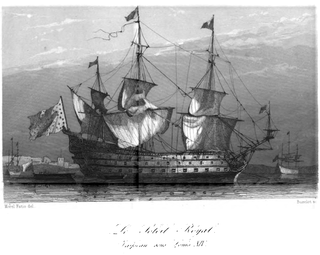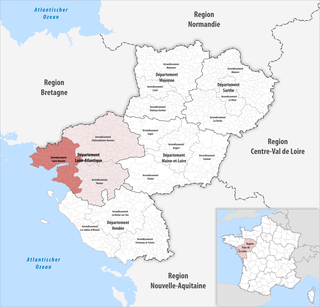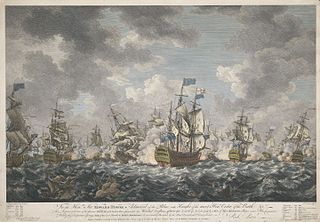Career
Juste was laid down in 1724 and launched in September 1725, joining the active service the next year. She was overhauled in Brest from 1741, where she sustained light damage on 25 December of the following year, when a fire started in the wood workshop propagated to her. She was again hove down in Brest in 1744, and overhauled in Rochefort in 1751. [1]
On 14 November 1759, under Captain François de Saint Aloüarn, [3] she was part of a 20-ship and 5-frigate strong squadron under Marshal de Conflans that was to attempt a landing in Cornwall for the planned French Invasion of Britain. The French fleet was intercepted by the English ships under Admiral Hawke on 20 November.
In the ensuing Battle of Quiberon Bay, Juste was in the rear-guard of the French fleet, taking the fourth position in the line of the srd Division. [2] Juste was engaged by up to four English ship and was severely battered, with a number of leaks and her rudder shattered; by 20:00, she was unable to fight, her captain mortally wounded and her first officer killed, [4] and limped back to Penchâteau Point to effect summary repairs. [2] She then attempted to proceed to Saint Nazaire [3] at low tide, and ran aground in the mouth of the Loire, at Chemoulin Point, [3] a few miles before reaching safety. Her crew threw all cargo overboard to lighten the ship and prevent her from breaking, even cutting her masts, but to no avail: Juste settled on the bottom and her crew abandoned the ship. She then broke and sank within the next three hours. [2] About 150 of her crew survived. [2]

The Battle of Quiberon Bay was a decisive naval engagement fought on 20 November 1759 during the Seven Years' War between the Royal Navy and the French Navy. It was fought in Quiberon Bay, off the coast of France near St. Nazaire. The battle was the culmination of British efforts to eliminate French naval superiority, which could have given the French the ability to carry out their planned invasion of Great Britain. A British fleet of 24 ships of the line under Sir Edward Hawke tracked down and engaged a French fleet of 21 ships of the line under Marshal de Conflans. After hard fighting, the British fleet sank or ran aground six French ships, captured one and scattered the rest, giving the Royal Navy one of its greatest victories, and ending the threat of French invasion for good.

The Redoutable was a Téméraire class 74-gun ship of the line of the French Navy. She took part in the battles of the French Revolutionary Wars in the Brest squadron, served in the Caribbean in 1803, and duelled with HMS Victory during the Battle of Trafalgar, killing Vice Admiral Horatio Nelson during the action. She sank in the storm that followed the battle.

The naval Battle of Lagos took place between a British fleet commanded by Sir Edward Boscawen and a French fleet under Jean-François de La Clue-Sabran over two days in 1759 during the Seven Years' War. They fought south west of the Gulf of Cádiz on 17 August and to the east of the small Portuguese port of Lagos, after which the battle is named, on the 18th.

France was the last of four Courbet-class battleships, the first dreadnoughts built for the French Navy. The ship was completed just before the start of World War I in August 1914. Even though France was not officially completed, she ferried the President of France to Russia during the July Crisis for consultations. She spent the war providing cover for the Otranto Barrage that blockaded the Austro-Hungarian Navy in the Adriatic Sea and sometimes served as a flagship. After the war France and her sister ship Jean Bart participated in the occupation of Constantinople and were then sent to the Black Sea in 1919 to support Allied troops in the Southern Russia Intervention. The war-weary crews of both ships briefly mutinied, but it was easily put down and she returned to France mid-year. Striking an uncharted rock off the French coast in 1922, she foundered four hours later.

Soleil Royal was a French 104-gun ship of the line, flagship of Admiral Tourville.

The arrondissement of Saint-Nazaire is an arrondissement of France in the Loire-Atlantique department in the Pays de la Loire region. It has 55 communes. Its population is 327,907 (2016), and its area is 1,758.1 km2 (678.8 sq mi).

The Soleil-Royal was a ship in the French Navy, the third ship of that name. She was the first 80-gun two-decker to use the 24-pounder long gun on her second battery, giving her a considerable firepower for the time and allowing her to challenge three-deckers. Her name Soleil-Royal, honouring the French crown and usually reserved for the largest units of the Navy, testifies of the change of focus from large three-deckers onto strong two-deckers.

Jean-Baptiste Philibert Willaumez was a French sailor, Navy officer, and admiral of the First French Empire.

Auguste was an 80-gun ship of the line in the French Navy, laid down in 1777 and in active service from 1779. She tooks part in the Naval operations in the American Revolutionary War and later in the French Revolutionary Wars, notably fighting at the Combat de Prairial. She was lost with most hands during the Croisière du Grand Hiver in January 1795.
Joseph-Marie Nielly (1751–1833) was a French naval officer and admiral.
Jean-François Tartu was a French Navy officer, and hero of the French Revolution.

A French invasion of Great Britain was planned to take place in 1759 during the Seven Years' War, but due to various factors was never launched. The French planned to land 100,000 French soldiers in Britain to end British involvement in the war. The invasion was one of several failed and defeated French attempts during the 18th century to invade Britain.
The Dauphin Royal was a 2nd Rank 74-gun ship of the line of the Royal French Royal Navy, designed in 1735 by Blaise Ollivier and constructed in 1735 to 1740 at Brest Dockyard. She and the contemporary Superbe, also built at Brest over the same period, were the last French 74-gun ships to have only thirteen pairs of lower deck guns. In 1747, she was rebuilt at Brest and reduced to 70 guns by the removal of her poop guns.
Hector was a 74-gun ship of the line of the French Navy, lead ship of her class. Hector was launched in 1755 and fought in the American Revolutionary War during which she captured two ships of the British Royal Navy on 14 August 1778. In 1782, the ship was captured by the Royal Navy at the Battle of the Saintes in 1782. Taken into service by the Royal Navy, the vessel was renamed HMS Hector. On 5 September 1782. HMS Hector fought two French frigates. Severely damaged during the battle, and by a hurricane that followed later in September, Hector sank on 4 October 1782.
Andromaque was a 32-gun Nymphe-class frigate of the French Navy.

Guichen was a protected cruiser of the French Navy launched in 1897, commissioned in 1899 and retired in 1921. She was constructed by Ateliers et Chantiers de la Loire at Saint-Nazaire.

The Golymin was a 74-gun ship of the line of the French Navy. Built in Lorient in 1804, she was launched in 1809. Wrecked on Mengam Rock in the roads of Brest on 23 March 1814, she is the source of the Obusier de vaisseau currently on display in the Musée national de la Marine in Paris and in Brest.

Palmier was a 74-gun ship of the line of the French Navy.

Intrépide was a 74-gun ship of the line of the French Navy. She was of three ships of the Monarque class, all launched in 1747, the others being Monarque and Sceptre.
Réolaise was a 20-gun ship-corvette of the French Navy. Originally a British merchantman, she was built in England, captured by the French and brought into naval service in 1793. She served as a convoy escort until she ran aground in combat at Port Navalo and was scuttled by fire.














